What is Ollantaytambo?
Ollantaytambo was one of the villages that came under the rule of the Incas. The city served as an important checkpoint. According to Inca laws, these lands were reserved for the dynasty of Inca rulers.
Learn all about the archaeological site of Ollantaytambo in Cusco, Peru.
- What does Ollantaytambo mean?
- When was Ollantaytambo founded?
- What is the historical importance of Ollantaytambo?
- How is the archaeological site of Ollantaytambo?
- What is the town of Ollantaytambo like?
- What places to visit in Ollantaytambo?
- The Temple of the Sun in Ollantaytambo
- The platforms of Ollantaytambo
- What else to see in Ollantaytambo?
- How to buy the ticket to visit Ollantaytambo?
- Interesting facts about the archaeological site of Ollantaytambo
- Questions and answers about Ollantaytambo
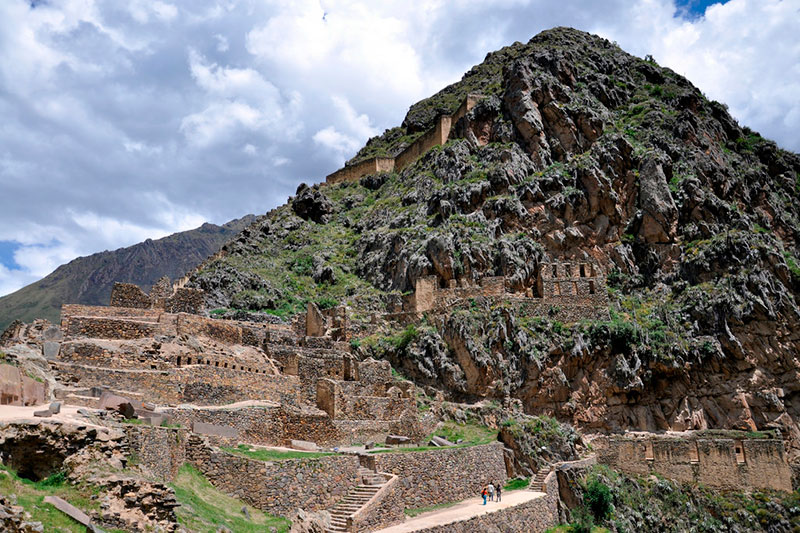
Inca Complex of Ollantaytambo
What does Ollantaytambo mean?
- According to various studies, Ollantaytambo is a word of Aymara origin (language of the Peruvian high plateau) that would mean “place of observation from below”.
- In Ollantaytambo, culture and history are deeply combined, producing the admiration of the people who visit it.
- If you decide to tour the city of Ollantaytambo on your trip to Machu Picchu, you will enjoy not only green and beautiful landscapes but also the daily life of the inhabitants of this ancient human settlement.
- According to oral tradition, Ollantaytambo owes its name to the Inca drama ‘Ollantay’, whose protagonist was the Inca general ‘Ollanta’.
When was Ollantaytambo founded?
- In the middle of the 15th century, Emperor Pachacutec destroyed the town that settled there to found Ollantaytambo and incorporate it into the Inca Empire.
- Pachacutec ordered the construction of the main buildings of the current archaeological site of Ollantaytambo.
- Pachacutec is known as the Inca builder. Under his rule, the Incas also built the Inca Citadel of Machu Picchu.
- Until today, the town of Ollantaytambo conserves its urban organization as well as many Inca walls.
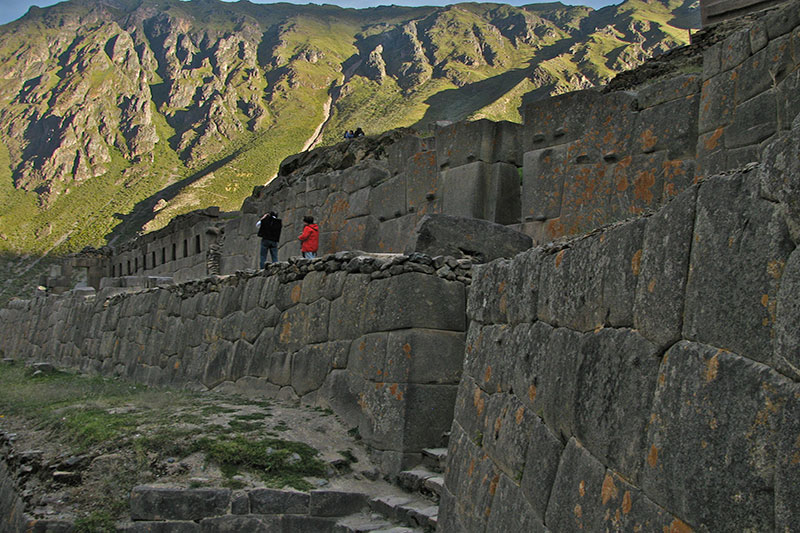
Inca walls in Ollantaytambo
What is the historical importance of Ollantaytambo?
- Ollantaytambo was an important religious, agricultural and also military center. Due to its strategic location during the conquest it served as a defense post against the Spanish.
- In 1537 the Spanish conquistadors faced off with the last Incas who resisted the European invasion in Ollantaytambo.
- The resistance of Manco Inca could not stop the Spanish attack so they had to flee to the city of Vilcabamba, in the jungle of Cusco.
- The city was in the hands of the invaders and being an ‘encomienda’ at the hands of Hernando Pizarro.
The encomiendas were territories placed at the disposal of the Spanish colonizers. Due to this, Ollantaytambo combines Inca, colonial and contemporary buildings.
How is the archaeological site of Ollantaytambo?
- Ollantaytambo is located at the top of the mountains from where the town is watched as well as all the Sacred Valley of the Incas.
- Ollantaytambo has some of the best construction work done by the Incas as the Sun Temple.
- It was believed for a long time that the city was a kind of defense fortress. However, the quality of the work suggests that it also served as a resting place for the Inca and his family.
What is the town of Ollantaytambo like?
- The town of Ollantaytambo retains its Inca urban layout very well organized with a polygonal design. The square is in the center of the same city.
- At present, the space occupied by the town of Ollantaytambo is a fraction that it had in antiquity.
- The south side of the town of Ollantaytambo shows a higher quality construction. The north side, on the other hand, has lower quality buildings.
- Currently, the town has various tourist services such as hotels, restaurants, cafes and many places to visit.
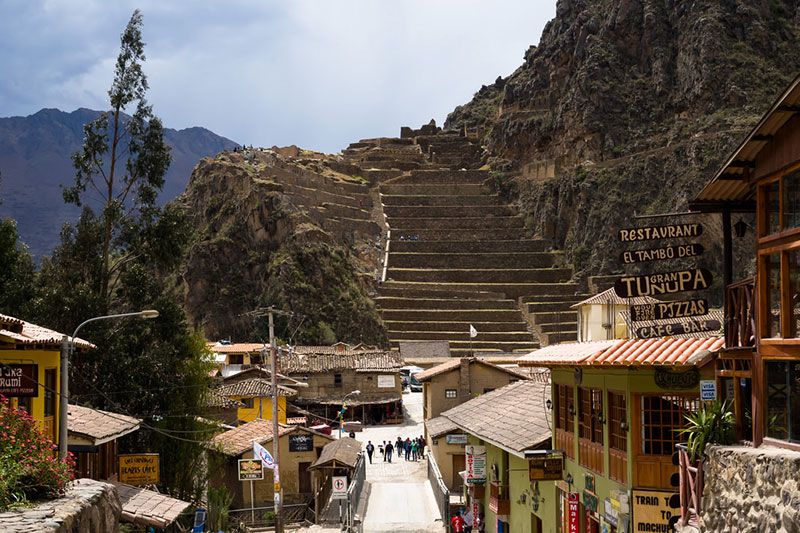
Entrance to Ollantaytambo
What places to visit in Ollantaytambo?
- The archaeological site of Ollantaytambo has various buildings such as the Ñusta Bath, the Real Casa del Sol, the Monumental Home and many others.
- However, the most popular and imposing buildings in Ollantaytambo are the Temple of the Sun and the beautiful andenería system.
- At the top of the mountains that surround Ollantaytambo you can visit some constructions called ‘Colcas’. These structures served as warehouses for basic products such as corn or potatoes.
The Temple of the Sun in Ollantaytambo
- To the west of the Ollantaytambo you will find a building known as ‘Aracama’. In this place is the Temple of the Sun.
- The Temple of the Sun is a unique building in the Sacred Valley.
- It is built on top of a pyramid of terraces that lead to the Main Square.
- In the Temple of the Sun 6 monoliths survive that form one of the most impressive buildings of the Sacred Valley of the Incas.
- The Temple of the Sun must have been a ceremonial place. It is also believed that they stopped construction during the Spanish invasion.
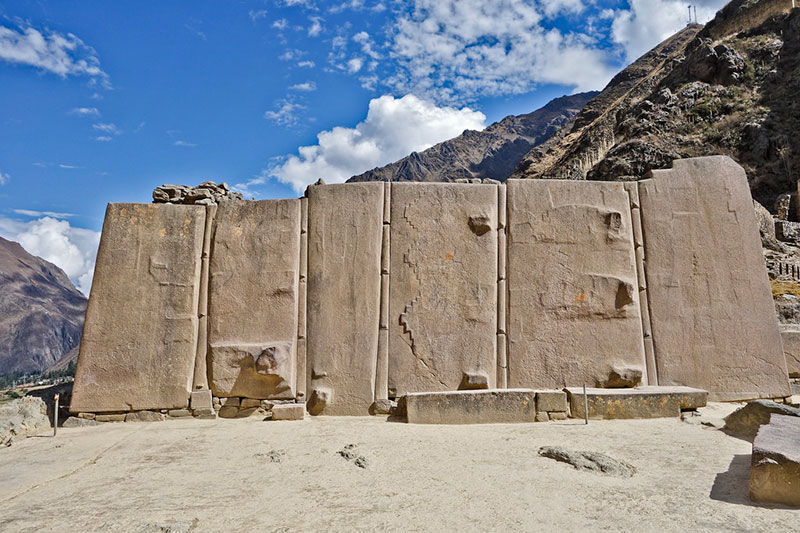
The Temple of the Sun in Ollantaytambo
The platforms of Ollantaytambo
- The agricultural terraces of Ollantaytambo are one of the best examples of agricultural engineering developed by the Incas.
- They are 700 meters long, 58 meters wide and 15 meters deep. Everything is built in relation to the position of the sun and the natural environment.
- The platforms create particular microclimates that allow the cultivation of different products in higher or lower areas.
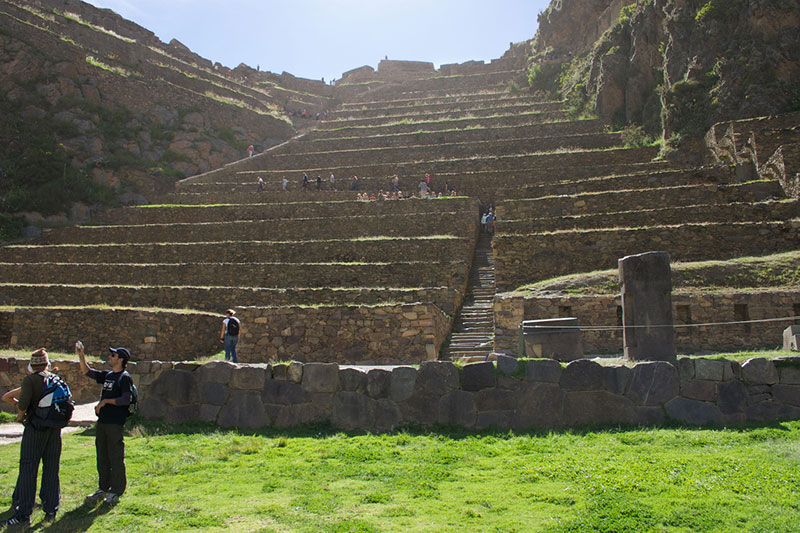
Andenería in Ollantaytambo
What else to see in Ollantaytambo?
- In Ollantaytambo you can also visit the abandoned quarries from which the construction material of the city was extracted.
- From Ollantaytambo you can take walks to Pumamarka or visit the Yanacocha lagoon.
- From Ollantaytambo the trains leave in the direction of Machu Picchu. Visit the archaeological site or the Inca people is a good option before knowing the Wonder of the World.
How to buy the ticket to visit Ollantaytambo?
- To enter Ollantaytambo you need to buy the Cusco Tourist Ticket circuit 3. This ticket, in addition to Ollantaytambo, includes admission to the archaeological sites of Moray, Chinchero and Pisac.
- The ticket can be purchased at the entrance gate of Ollantaytambo or at the authorized offices in the city of Cusco: Avenue El Sol 103 or Calle Garcilaso s/n.
- The cost of the Cusco Tourist Ticket is 70 soles. The tourist has up to two days to visit all the places included in this ticket.
- The purchase of this ticket is only in person. At the moment it cannot be purchased online.
Interesting facts about the archaeological site of Ollantaytambo
- The town of Ollantaytambo is full of Inca constructions. In addition to its archaeological site in the surrounding mountains, you can distinguish colcas, enclosures and even an Intipunku (gate of the sun). To get to this last construction, you must walk approximately 2 hours.
- Ollantaytambo also celebrates an Inca festival similar to the famous Inti Raymi of Cusco. This is ‘Ollantay Raymi’, a staging based on the historic drama of Ollantay. The main stage of this festivity is the archaeological site of Ollantaytambo. That day, at the end of June, the staging takes place with hundreds of visitors.
- The archaeological site of Ollantaytambo can be visited with the ‘Sacred Valley of the Incas 1 day Tour’. This service offers complete transportation, entrance to all sites, lunch in Urubamba and professional tour guide service. The places to visit are the archaeological sites of Pisac, Chinchero and, of course, Ollantaytambo. The cost of the tour varies from 30 to 70 dollars per tourist. It depends on the tourism agency you choose.
Questions and answers about Ollantaytambo
1) Who ordered the construction of Ollantaytambo?
Emperor Pachacutec was the one who ordered the embellishment and construction of the current archaeological site of Ollantaytambo in the mid-15th century. Shortly before he had conquered this town and extended the limits of the Inca empire.
2) What does Ollantaytambo mean?
The word Ollantaytambo, translated from Quechua Ullantaytampu, means ‘Ollanta inn’. This name refers to the character of ‘Ollanta’ in the drama of ‘Ollantay’ who was an Inca general who ruled in this Andean town.
3) What to see in Ollantaytambo?
Ollantaytambo is famous for its Inca archaeological site. There you can see amazing stone constructions such as: the Temple of the Sun, the Royal House of the Sun, the Monumental Portal, the Enclosure of the 10 niches, the Ñusta baths and more.
4) What was the function of Ollantaytambo?
Ollantaytambo was an Inca citadel that, like many, had temples, platforms (agricultural production) and enclosures for people of high society as well as the common people. However, in the 16th century it also served as a fortress due to the battle between the Spanish and the Incas.
5) Who fought in Ollantaytambo?
The chronicles indicate that in January 1537 in Ollantaytambo the army of Manco Inca (leader of the Vilcabamba rebellion) clashed against the Spanish army led by Hernando Pizarro. The Incas resisted there until they were defeated so they fled to the jungle of Cusco (Vilcabamba).
6) Is it dangerous to visit Ollantaytambo?
Ollantaytambo offers a safe visit. There are no risky sections for the visitor’s health. However, it is recommended not to approach the margins of the paths.
7) How high up is Ollantaytambo?
Ollantaytambo is situated at 2,792 meters above sea level.
8) What landscapes can I see in Ollantaytambo?
In Ollantaytambo you can appreciate natural landscapes of great beauty such as the Urubamba River, a set of farmlands as well as the Verónica, Chicón and Sahuasiray snow-capped mountains.
9) How to go from Cusco to Ollantaytambo?
The trip from Cusco to Ollantaytambo can be done by public transport. To do this, you must take the public transport minivans that leave from Pavitos street (in the historic center of Cusco). The journey takes 1 hour 40 minutes. It costs 10 soles on average.
10) How much does a tour to Ollantaytambo cost?
The visit to Ollantaytambo is included in the tour to the Sacred Valley of the Incas for 1 day. This service also includes admission to the Inca sites of Chinchero and Pisac. The tour includes everything: transportation, guide, tickets and even lunch. The cost varies from 30 to 70 dollars, depending on the tourism agency you choose.
By Ticket Machu Picchu – Last updated, March 11, 2022